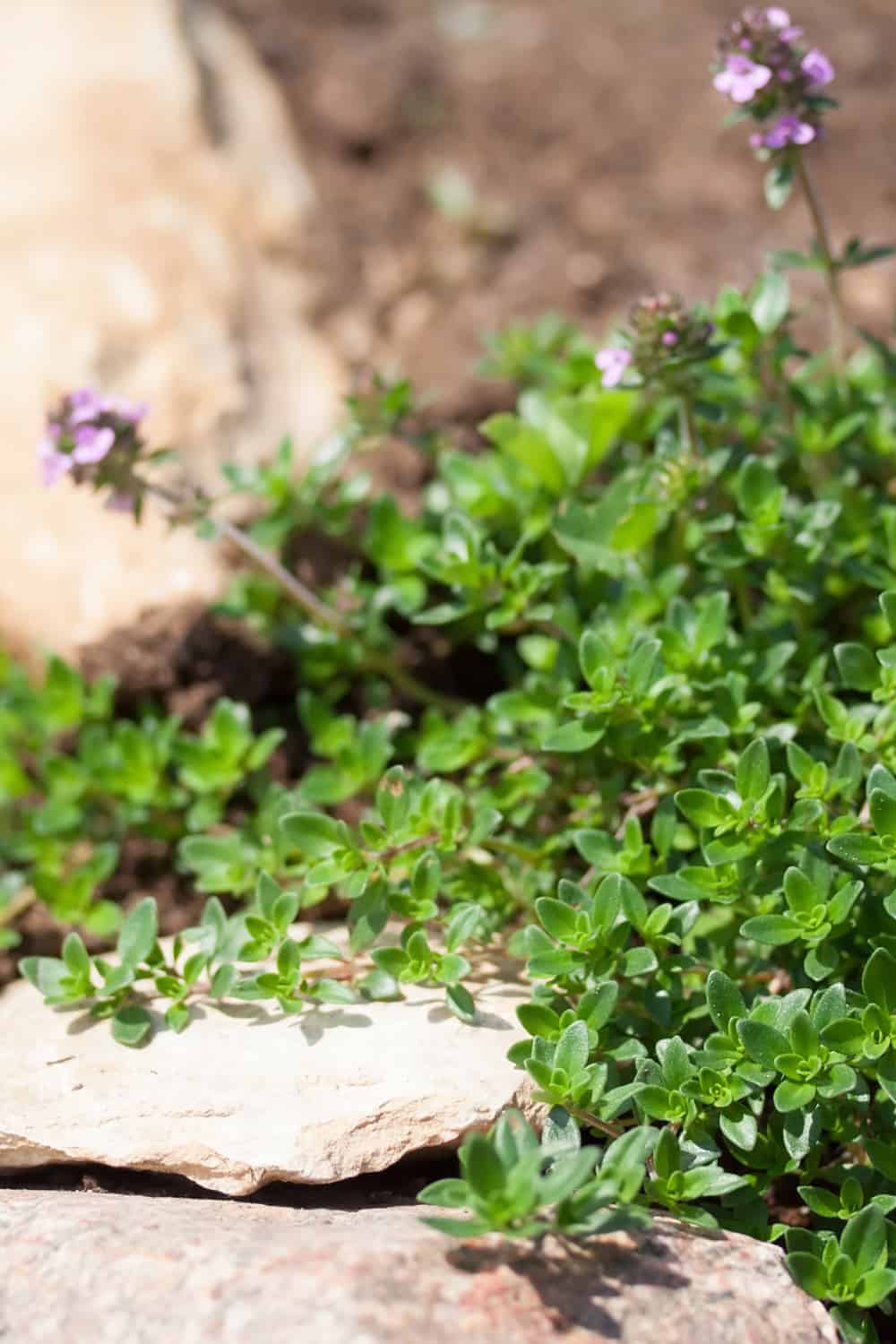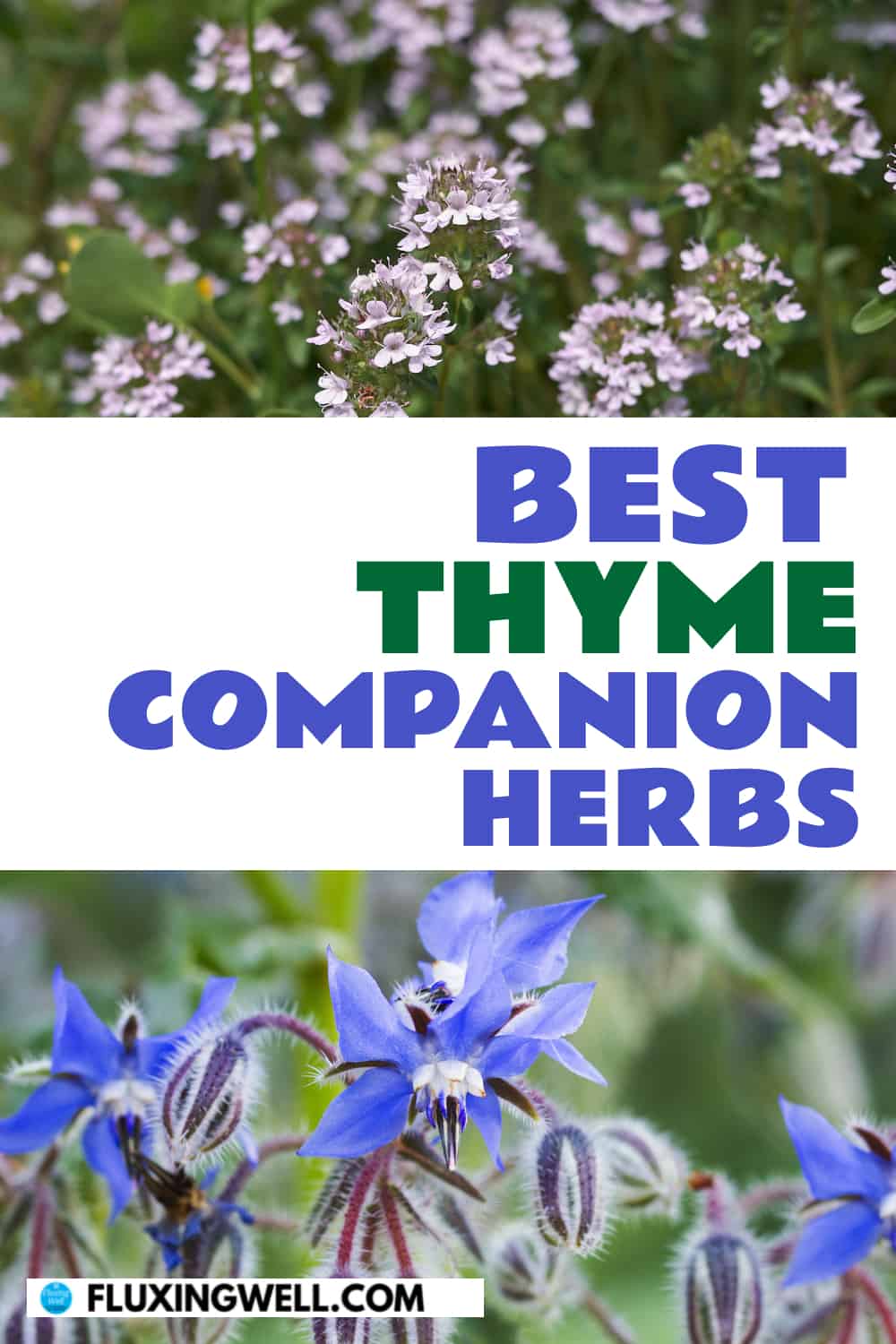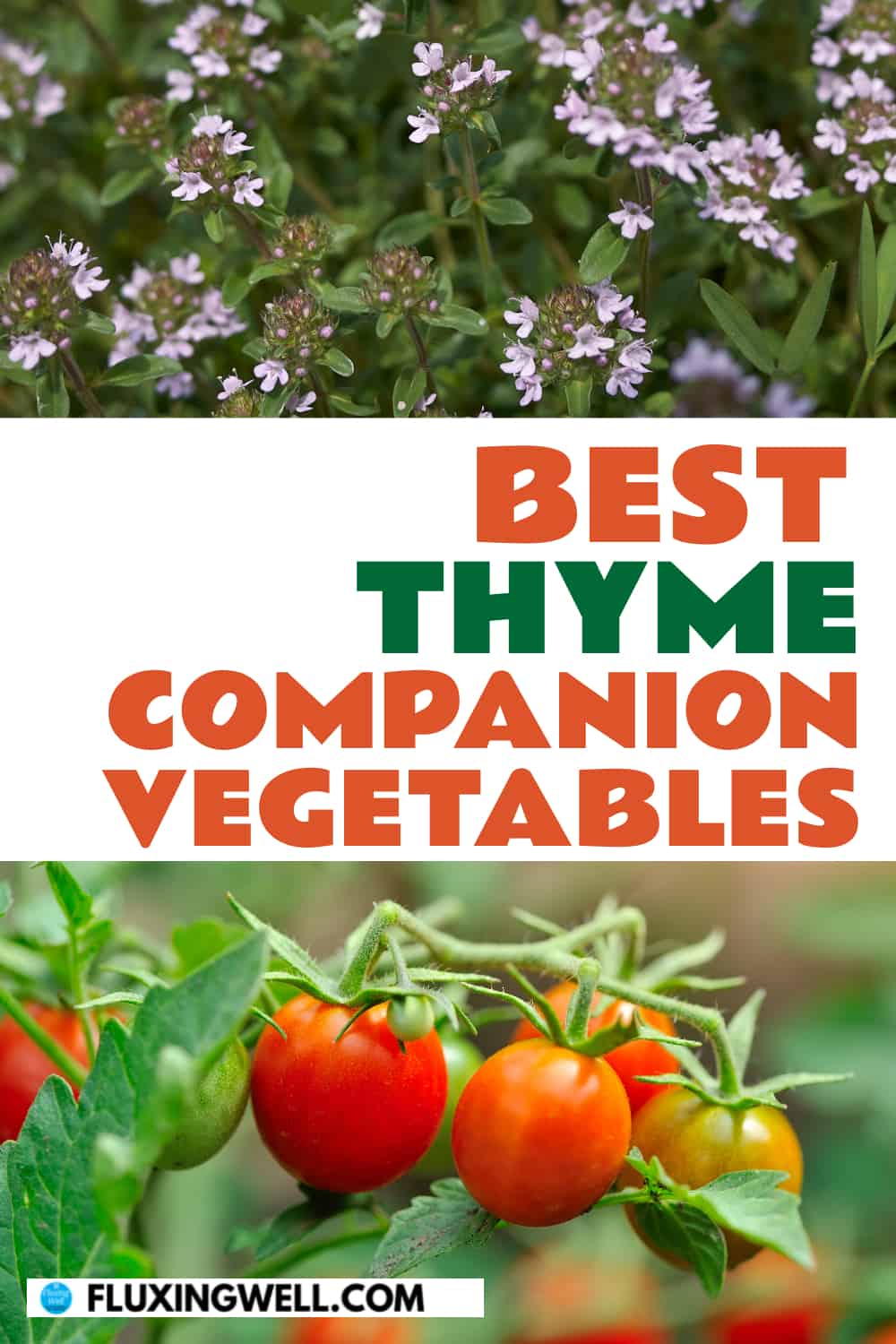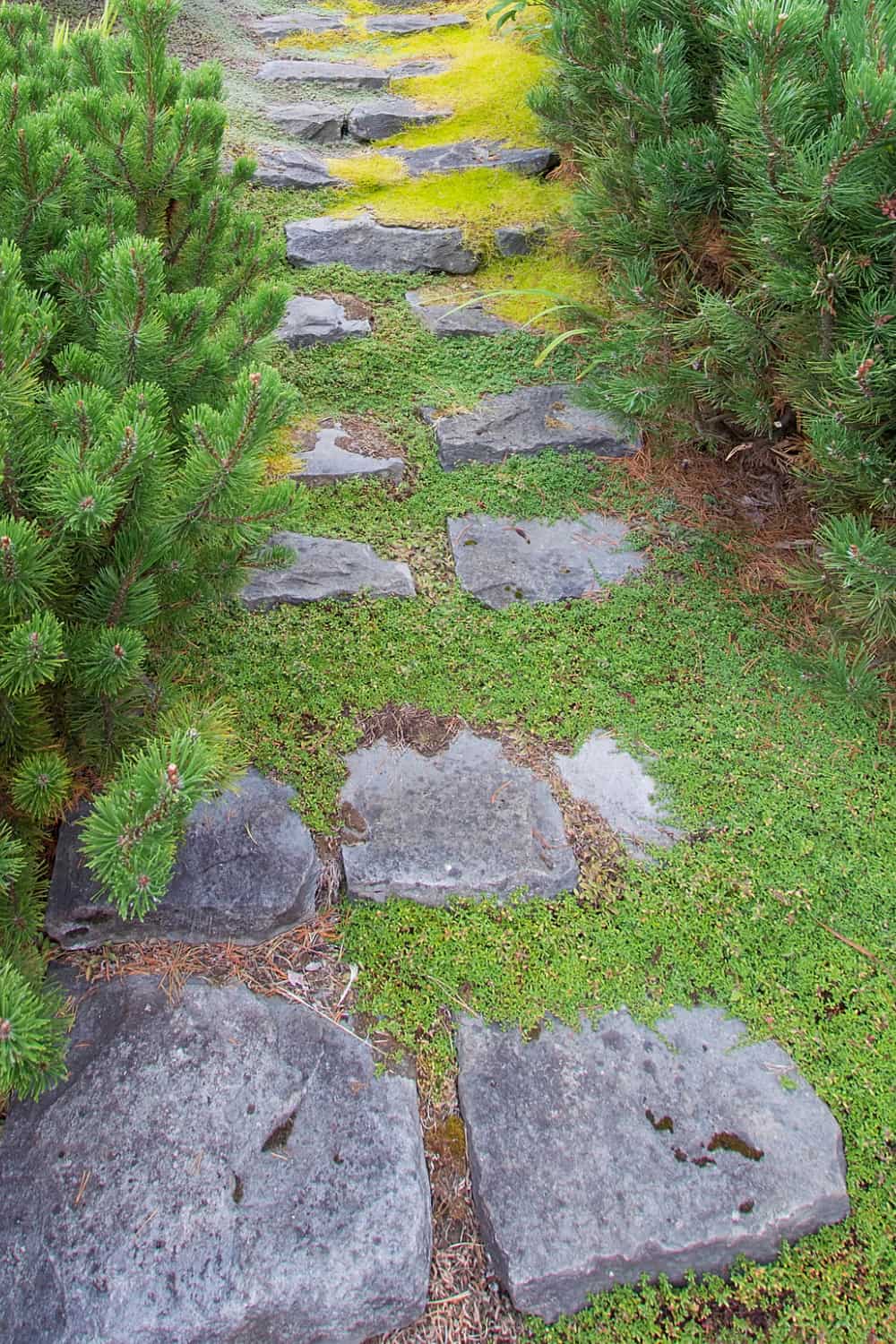Learn about the best thyme companion plants you can surround your thyme with to help this fragrant perennial herb thrive. Find out what you can plant next to thyme and what you should not plant near thyme. Get ideas about which flowers grow well with thyme, which fruit grows well with thyme, which herbs grow well with thyme, and which vegetables grow well with thyme.
You will also learn about the best place to plant thyme, the best fertilizer for thyme, and whether thyme needs a lot of water. I’ve been growing thyme for over 20 years and using thyme in recipes (like homemade broccoli cheese sauce or savory bacon-wrapped meatloaf). If you are looking for an easy-to-grow, deer-resistant addition to your plant collection, read on to learn how simple it is to grow thyme in your garden. Whether you are using thyme for culinary or decorative purposes, discover how versatile this low-maintenance herb can be. Get a handy chart listing companion plants for thyme as well. Let’s get started!
Table of Contents
Thyme: A Favorite Filler with Great Culinary Potential
When we first started landscaping our property nearly three decades ago, we unearthed a lot of rocks. These were not small rocks, but large boulders. What did we do? We (mainly my husband) made some rock walls, of course. To soften up the edges, we stuck little starts of thyme along the top. In a very short period, the thyme and its little pink flowers were draping over the edges and cascading down the sides of the rocks, helping the rock walls to look established as if they had been there for much longer.
We also placed thyme in between the flagstones along our walkway, filling in the bare spaces and helping to keep the weeds from encroaching. A bonus was the subtle fragrance that was released when the thyme was trodden upon. Garden pests like slugs and deer left it alone. All these years later, I’m still a big fan of this easy-care plant. If you are thinking of adding thyme to your garden landscape, here is all you need to know to get started with this fabulous, low-maintenance plant.
What Makes a Good Companion Plant?
Why pay attention to companion plants? A good companion plant is one that offers various benefits to its neighboring plants, such as minimizing pest and disease issues, which helps enhance their growth, health, and overall productivity. Here are some key qualities that make a good companion plant that will help you plant strategically to make the most of your yard or garden space:
Pest Control: Companion plants may repel pests or attract beneficial insects that prey on pests, helping to reduce pest damage without the need for chemical pesticides.
Pollinator Attraction: Plants that attract pollinators such as bees, butterflies, and hummingbirds can improve pollination and fruit set in neighboring plants, leading to higher yields.
Soil Improvement: Some companion plants have deep roots that help break up compacted soil, while others fix nitrogen or add organic matter to the soil, improving soil fertility and structure for neighboring plants.
Complementary Growth Habits: Companion plants with different growth habits, such as tall plants providing shade for shorter ones or ground covers suppressing weeds, can maximize space and resources in the garden.
Disease Resistance: Certain companion plants may emit chemicals or compounds that inhibit the growth of pathogens or pests, reducing the risk of disease in neighboring plants.
Seasonal Considerations: Companion plants that thrive during different seasons can provide continuous benefits throughout the year, such as early bloomers attracting pollinators or cover crops protecting soil during the off-season.
Aesthetic Value: Companion plants with attractive foliage, flowers, or fruits can enhance the visual appeal of the garden while providing practical benefits to neighboring plants.
Thyme Companion Plants: Flowers
Several annual flowers make excellent companions for thyme in the garden. These annual flowers not only add beauty to the garden but also provide various benefits such as pest control and pollination support for thyme. Here are some of my favorite options:
Alyssum (Lobularia maritima): Alyssum produces tiny flowers that attract beneficial insects like hoverflies and lacewings, which prey on aphids and other pests that may harm thyme.
Cosmos (Cosmos bipinnatus): Cosmos attract pollinators such as bees and butterflies, which can benefit thyme by enhancing its pollination.
Marigolds (Tagetes spp.): Marigolds are known for their pest-repelling properties and can help keep harmful insects away from thyme.
Nasturtiums (Tropaeolum spp.): Nasturtiums are edible flowers that can help repel pests like aphids and attract beneficial insects to the garden.
Zinnias (Zinnia elegans): Zinnias are colorful and attractive to pollinators, helping to increase biodiversity in the garden and support thyme growth.
Thyme Companion Plants: Fruit
While fruits are not typically planted alongside thyme, some fruit-bearing plants can still make good companion plants in certain situations. Here are a few fruits that can potentially complement thyme:
Apples or pears: These fruit trees can be planted in a larger garden where there’s plenty of space between them and the thyme. They provide shade and habitat for beneficial insects and can create a more diverse ecosystem.
Blueberries: Blueberries have similar soil preferences to thyme, preferring acidic, well-draining soil. While they are larger plants, they can still be planted nearby without competing too much with thyme. Both blueberries and thyme can attract beneficial insects.
Currants: Currant bushes, like black currants or red currants, can provide a bit of height without overshadowing thyme. They can be planted nearby to add diversity to the garden and attract pollinators.
Strawberries: Strawberries are low-growing plants that can be interplanted with thyme. They have shallow roots and don’t compete much with thyme for nutrients or space. Plus, they attract pollinators, which can benefit both crops.
Thyme Companion Plants: Herbs
By planting companion herbs alongside thyme, you can create a diverse and harmonious herb garden that not only looks beautiful but also enhances the flavors of your culinary creations. Here are some herbs that pair well with thyme:
Basil (Ocimum basilicum): Basil and thyme are versatile culinary herbs that complement each other well in various dishes. Basil’s strong aroma can help deter pests and enhance the overall flavor of the garden.
Borage (Borago officinalis): Borage attracts pollinators and improves the overall health of surrounding plants, including thyme, by enriching the soil with nutrients through its deep taproot.
Chamomile (Matricaria chamomilla): Chamomile attracts beneficial insects and has a pleasant aroma. It can also enhance the flavor of nearby herbs like thyme.
Lavender (Lavandula angustifolia): Lavender attracts pollinators and shares similar growth conditions with thyme, thriving in well-drained soil and full sunlight.
Oregano (Origanum vulgare): Oregano and thyme are both members of the mint family (Lamiaceae) and share similar growing conditions. Planting them together can create a lush herb garden while providing culinary diversity.
Parsley (Petroselinum crispum): Parsley is a biennial herb that can be planted alongside thyme to provide visual interest and culinary versatility. Its upright growth habit contrasts nicely with thyme’s low, spreading habit.
Rosemary (Rosmarinus officinalis): Rosemary and thyme are both Mediterranean herbs with similar cultural requirements, such as well-drained soil and full sunlight. They complement each other in culinary dishes and can be planted together to create a fragrant herb garden.
Sage (Salvia officinalis): Sage is a compatible companion for thyme as both herbs have similar care requirements and can thrive together in the same growing conditions. Additionally, their combined aromas create a pleasant garden scent.
Thyme Companion Plants: Vegetables
Thyme can be a beneficial companion to many vegetables in the garden, providing various advantages such as pest repellence, flavor enhancement, and attracting beneficial insects. Here are some of the best companion vegetables for thyme:
Beans: Thyme’s aromatic foliage can help repel bean beetles and other pests that may target bean plants. Additionally, thyme’s shallow roots won’t compete much with the deeper root systems of bean plants.
Cabbage family (e.g., cabbage, broccoli, cauliflower): Thyme can help deter cabbage moths, cabbage loopers, and other pests that commonly affect members of the cabbage family. Planting thyme alongside these vegetables can help protect them from pest damage.
Eggplant: Thyme can help deter pests like flea beetles and spider mites that often target eggplants. Its low-growing habit also provides ground cover and helps conserve moisture in the soil.
Lettuce: Thyme can help deter slugs and snails, common pests of lettuce plants. Its low-growing habit also provides ground cover and helps suppress weed growth around lettuce plants.
Peppers: Thyme can assist in repelling aphids, spider mites, and other pests that may affect pepper plants. The aromatic oils in thyme can also enhance the flavor of peppers when grown nearby.
Tomatoes: Thyme can help repel pests that commonly affect tomatoes, such as whiteflies and cabbage loopers. Additionally, the aromatic foliage of thyme can enhance the flavor of tomatoes when grown nearby.
What Should Not Be Planted with Thyme?
While thyme is a versatile and relatively low-maintenance herb, certain plants may not make good companions due to various reasons such as competing for resources, incompatible growing conditions, or allelopathic effects (chemicals released by one plant that inhibit the growth of another). Here are some plants that may not be the best companions for thyme:
Cilantro/Coriander: Cilantro and coriander are fast-growing annual herbs that can quickly overshadow and shade out thyme if planted together. Additionally, cilantro may attract pests like aphids and whiteflies, which can potentially affect thyme plants.
Dill: Dill is known to attract pests like aphids and spider mites, which can potentially spread to nearby thyme plants. Additionally, dill can grow tall and may shade out thyme if planted too closely together.
Fennel: Fennel has a deep taproot and can be allelopathic, releasing chemicals that inhibit the growth of nearby plants. It may compete with thyme for resources and stunt its growth.
Mint: Mint has a vigorous spreading habit and can become invasive if not properly contained. It may compete with thyme for space, water, and nutrients in the garden. Additionally, mint prefers more moisture and shade than thyme, so their growing requirements may not align well.
Thyme Companion Planting Chart
| Thyme Companion Plants | |
| Thyme Companion Plants: Flowers | Thyme Companion Plants: Fruit |
| Alyssum | Apples |
| Cosmos | Blueberries |
| Marigolds | Currants |
| Nasturtiums | Pears |
| Zinnias | Strawberries |
| Thyme Companion Plants: Herbs | Thyme Companion Plants: Vegetables |
| Basil | Beans |
| Borage | Cabbage |
| Chamomile | Eggplant |
| Lavender | Lettuce |
| Oregano | Peppers |
| Parsley | Tomatoes |
| Rosemary | |
| Sage | Worst Thyme Companion Plants |
| Cilantro | |
| Coriander | |
| Dill | |
| Fennel | |
| Mint | |
Common Questions About Planting and Growing Thyme
When should thyme be planted?
Thyme can be planted either from seeds or seedlings, and the timing depends on your climate and growing conditions. Here are some general guidelines for when to plant thyme:
Spring: Thyme can be planted outdoors in the spring after the last frost date has passed and the soil has warmed up. In cooler climates, this is typically in late spring or early summer.
Fall: In regions with mild winters, fall is also a suitable time to plant thyme. Planting in the fall allows the roots to establish before the onset of winter, giving the plant a head start for the following spring.
Indoors: If you’re starting thyme from seeds indoors, you can begin sowing them 6-8 weeks before the last frost date in your area. This will give the seedlings time to grow before they’re transplanted outdoors.
Where should thyme be planted?
When planting thyme, choose a location that provides ample sunlight, well-drained soil, and room for the plant to spread. Here are some additional tips about where to plant thyme:
Sunlight: Thyme prefers full sunlight, so choose a location in your garden that receives at least 6-8 hours of direct sunlight per day. Avoid planting thyme in shaded areas, as it may become leggy and produce fewer leaves.
Soil: Thyme thrives in well-drained soil with a slightly alkaline to neutral pH (around 6.0 to 8.0). Ensure that the soil is loose and not too compacted to allow for good drainage. If your soil is heavy or clayey, consider amending it with organic matter like compost to improve drainage.
Containers: Thyme grows well in containers, making it a great option for small gardens, balconies, or patios. Choose a pot with drainage holes at the bottom to prevent waterlogged soil, and use a well-draining potting mix specifically formulated for herbs.
Borders and edging: As previously noted, thyme’s low-growing and spreading habit makes it an excellent choice for planting along borders, pathways, or garden edges. It can create a fragrant and visually appealing ground cover while also discouraging weeds from growing.
Rock gardens: As my family discovered, thyme is well-suited for rock gardens or dry, rocky areas where other plants may struggle to grow. Its drought-tolerant nature and ability to thrive in poor soil make it an ideal choice for these challenging environments.
What is the best fertilizer for thyme?
Thyme is a relatively low-maintenance herb that doesn’t require heavy fertilization. However, providing some nutrients can help promote healthy growth and enhance flavor. When fertilizing thyme, it’s essential not to over-fertilize, as this can lead to excessive foliage growth at the expense of flavor. Follow the recommended application rates and avoid applying fertilizer directly to the foliage to prevent leaf burn. Additionally, always water thyme plants after fertilizing to help distribute the nutrients evenly in the soil. If you feel the need to fertilize your thyme, here are some options:
Organic compost: Compost is an excellent natural fertilizer for thyme and other herbs. It provides a slow-release source of nutrients, improves soil structure, and encourages beneficial microbial activity in the soil. Apply a layer of compost around thyme plants in the spring or fall, or mix it into the soil when planting.
Fish emulsion: Fish emulsion is a liquid fertilizer made from fish byproducts and is rich in nutrients like nitrogen, phosphorus, and potassium. (It’s also very smelly.) Dilute fish emulsion according to the manufacturer’s instructions and apply it to thyme plants every 4-6 weeks during the growing season.
Liquid seaweed fertilizer: Liquid seaweed fertilizer is derived from seaweed and contains a variety of nutrients, trace minerals, and growth-promoting hormones. It can help stimulate root development, improve plant health, and enhance flavor. Dilute liquid seaweed fertilizer according to the manufacturer’s instructions and apply it to thyme plants every 2-4 weeks during the growing season.
Herb-specific fertilizer: Some commercial fertilizers are specifically formulated for herbs like thyme. These fertilizers typically contain balanced ratios of nitrogen, phosphorus, and potassium, as well as micronutrients. Follow the manufacturer’s instructions for application rates and frequency.
Slow-release granular fertilizer: Slow-release granular fertilizers provide a steady supply of nutrients to thyme plants over an extended period. Look for a fertilizer with a balanced NPK ratio (such as 10-10-10) and apply it according to the manufacturer’s instructions.
How much water does thyme need?
It is essential not to overwater thyme, as it is susceptible to root rot if the soil remains consistently soggy. You should adjust your watering frequency based on environmental conditions and the moisture needs of the plants. With that in mind, here are some guidelines for watering thyme:
Established plants: Once thyme plants are established, they typically only need water during dry spells or prolonged periods without rain. Water the plants deeply when the top inch of soil feels dry to the touch. Allow the soil to dry out between waterings to prevent root rot.
Container-grown thyme: Thyme grown in containers may need more frequent watering than those planted in the ground, as containers tend to dry out faster. Check the soil moisture regularly and water when the top inch of soil feels dry. Ensure that the container has drainage holes to prevent waterlogging.
Avoid overhead watering: Water thyme at the base of the plant rather than overhead to prevent moisture from accumulating on the foliage, which can increase the risk of fungal diseases.
Mulching: Applying a layer of organic mulch around thyme plants can help conserve soil moisture and reduce the frequency of watering. Mulch also helps suppress weed growth and regulates soil temperature.
Rainfall: Thyme can often rely on natural rainfall to meet its water needs, especially in regions with regular rainfall patterns. However, during dry periods or in areas with irregular rainfall, supplemental watering may be necessary. Where we live in Oregon, watering our thyme is rarely necessary. I was not kidding when I praised the plant for being low-maintenance.
What are the different varieties of thyme?
Thyme comes in various cultivars, each with its own unique characteristics in terms of flavor, aroma, growth habit, and appearance. When choosing a variety of thyme, consider your intended use and whether you want to use thyme in cooking, landscaping, or both. Here are some popular varieties of thyme:
Common Thyme (Thymus vulgaris): This is the most widely grown and commonly used variety of thyme. It has small gray-green leaves and a strong, earthy flavor. Common thyme is versatile and can be used in a wide range of culinary dishes.
Creeping Thyme (Thymus serpyllum): Creeping thyme has a low-growing, spreading habit and is often used as a ground cover or in rock gardens. It has a strong, earthy flavor and can be used fresh or dried in culinary applications. It can also be used as a spiller in a perennial flower container.
English Thyme (Thymus vulgaris ‘English’): English thyme is similar to common thyme but tends to have a slightly milder flavor. It is a favorite in English cooking, where it is used in a variety of savory dishes, including roasted meats, stuffing, and sauces.
French Thyme (Thymus vulgaris ‘French’): French thyme is known for its strong flavor and robust growth habit. It has slightly larger leaves than common thyme and is often used in French cuisine, particularly in stews, soups, and marinades.
Lemon Thyme (Thymus citriodorus): Lemon thyme has a citrusy aroma and flavor, reminiscent of lemon. It adds a bright, refreshing taste to dishes and pairs well with fish, poultry, and vegetables. Lemon thyme also has attractive variegated leaves.
Silver Thyme (Thymus vulgaris ‘Argenteus’): Silver thyme has variegated leaves with silver-gray edges, adding visual interest to the garden. It has a mild flavor similar to common thyme and can be used in the same way in cooking.
Need More Planting Ideas?
Check out the tips for the best companion plants for eggplant to learn what to grow with those beauties. If you like the idea of companion planting, you might be interested in reading about the best companion plants for pumpkins, sunflowers, garlic, asparagus, rosemary, radishes, beetroot (beets), parsley, lupine, echinacea, or the best companion plants for lavender. Get tips for growing stunning dahlias. Are you a beginning gardener? Try planting some foolproof, easy-care perennials, or learning about the best companion plants for columbine. There are so many exciting plants to grow!
Keep Track of Your Garden with a Journal Logbook
Now that you have learned about some compatible companion plants, keep track of your planting ideas, goals, and plans with a printable, editable free garden journal logbook. Choose the pages you want to use and customize them as you wish to record monthly, weekly, and daily garden tasks, lists, weather, and planting arrangements. There are also grid pages for easily designing the layout of your vegetable garden, flower garden, or landscape. Print it out and put it into a notebook you can take with you to the garden (that’s what I do). It’s nice to have all of your garden information in one place.
Get the garden journal logbook!
Free Online Garden Planner Layout Template
Now that you know which are the best companion plants for thyme, you might need a way to plan your garden layout. Whether you are planting vegetables, flowers, or herbs near your thyme plants, this online garden planner can help you visualize your design and bring it to life. Arrange and rearrange the plants over and over, then print the layout when you are satisfied. With garden tasks that need your attention, this is one way to save time.
It’s fully customizable when you make your own copy and includes two editable chart pages for noting planting specifications.
Get my free online garden layout planner template!
Have a wonderful week, and may all of your thyme-growing endeavors meet with success!

Lisa Mitchell is a wife, mom, and school librarian who likes to grow fruit, herbs, vegetables, and flowers on her family’s small Pacific Northwest farm. To learn more about what this website has to offer gardeners, click on over to the Garden page.
Want more great garden, food, or travel ideas? Follow FluxingWell on Pinterest, Facebook, Instagram, and X for the latest posts, tips, and inspiration.











Thank you for highlighting the best thyme companion plants along with some helpful growing tips, as well as a free chart. It’s interesting that thyme can do so well in rocky areas where other plants may struggle to grow. Great for certain areas of my property.
Yes, thyme can grow in places without much soil. I hope you get to plant some and give thyme a try.
Lisa, thanks for this wonderful and helpful article about thyme companion plants. Thyme is one of my favorite herbs but I haven’t tried growing it myself. Your tips are a perfect guide!
Oh, nice! I encourage you to plant some thyme, even if you only have a limited space on a windowsill.
This is a very thorough post on thyme companion plants. Last year I planted cilantro next to my thyme. Now I know not to do that this year. Thanks for all the ideas on better choices.
You are most welcome. May all of your future thyme-growing efforts meet with great success.
I know nothing about growing herbs, not to mention what companion plants are best! I love the look of thyme, so I’ll look into that this season. I love the soft look as you mentioned that thyme is perfect for borders and rock gardens, your rock garden is so cool. I would love to use some fruit as a thyme companion plant, what would you recommend that is deer-resistant? Great article on thyme companion plants and what to avoid!
Unfortunately, I have not been able to find a fruit that is deer resistant. We have a tall fence around our orchard and have to use bird netting over our berries to keep deer away. Creeping thyme would make a great ground cover under blueberries, as long as you were okay with draping bird netting over the blueberry bushes in the spring and summer. You can read more about planting blueberries here.
Thank you for all of these tips and ideas for companion plants to grow with thyme. I need something to cover the ground in some bare spots. The ability to use it in recipes is a plus.
I am so glad you are going to plant some thyme, and happy that you liked the list of thyme companion plants. Enjoy planting and growing thyme!